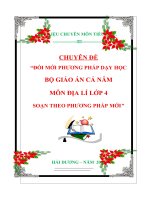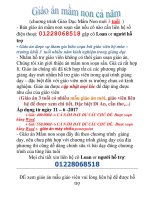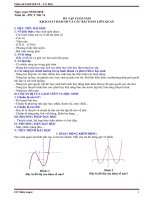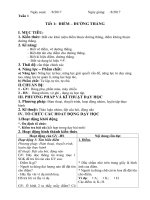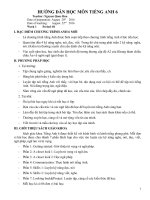Giao an ca nam mau moi
Bạn đang xem bản rút gọn của tài liệu. Xem và tải ngay bản đầy đủ của tài liệu tại đây (163.89 KB, 12 trang )
Teaching plan
English grade 8
WEEK 1
Period 1
Preparing date : 15/8/2017
Teaching date:
Class 8A: 22 /8/2017
Class 8B: 23 /8/2017
Class 8C:23 /8/2017
INTRODUCE ABOUT ENGLISH SUBJECT
I./OBJECTIVES:
1. Knowledge.
By the end of the lesson, Ss will be able to:
- Know about the English 8 student's book and the workbook
- Know how to learn English 8 effectively
2. Skills.
- Communication.
3. Attitudes.
- Students have serious attitude in learning.
- Ss are interested in learning English.
4. Competence.
- Co-operation
- Self- study
- Using knowledge to do exercises
II./ PREPARATIONS.
1- Teacher :- Text book, pictures, extra board, laptop…
2 - Students : - Notebook, textbook.
III./ TEACHING METHODS.
- Groupwork, pairwork, games, communication approach.
IV./PROCEDURES
Têảch and students’ activities
1./.Warm up : Kim's game
? Look through all the names of the
6 Unit in the Student's book in 10
seconds and try to remember as
many names as possible.
Contents
- Look at the names of the units only
.
- Teacher divide the class into two - Work in groups
teams.
? Go to the board and write the
- Write on the board.
words
- Teacher gets feedback
2. Presentation.
1. Introduce the time to learn
- T asks Ss some questions.
- Ss answer the questions and take
notes
? How many weeks are there in a
- 37 weeks
school year?
? How many weeks are there in the - 19 weeks
first terms?
- English 8, Student's book is the
third of four levels English
language textbooks for Vietnamese
students in lower secondary school
learning English as a foreign
language. It focuses on the use of
language
(pronunciation,
vocabulary, and grammar) to
develop the four language skills
(listening, speaking, reading and
writing)
? How many units are there in the
first terms?
3. Introduce about English book.
2. The content of the text book.
- There are 6 topic-based units in term 1:
- There are two mains themes: Our Unit 1: Leisure activities
Communities and Our Heritage
Unit 2: Life in the countryside
- After each theme is a review
Unit 3: People of Viet Nam
- There are two 45-minute tests:
Unit 4: Our customs and traditions
Unit 5: Festivals in Viet Nam
one after unit 3 and another after
Unit 6: Folk tales
unit 5
* Introduce the workbook .
? What is the Workbook about?
? Study the Workbook quickly then
answer the question
- The workbook mirror and
reinforces the content of the
Student's book.
+ Further practice of the
language and skills taught in class
+ Four additional tests for
students' self-assessment.
*How to learn English 8
effectively
? Discuss in groups of 3 or 4 about
"How to learn English 8
effectively?"
- Prepare the lesson carefully before
each period
- Learn by heart all the new words
and structures
- Do exercises regularly
- Practice the four skills
4. Further practice
? Recall how to learn English 8
effectively?
Study the workbook quickly then answer the
question
3. How to learn
Discuss and tell the class
- Reading the text and doing exercises before
going to class.
- Ss need to learn by heart vocabulary and
their usage in each unit.
- Review the lesson everyday.
- English is not too difficult but it requires
you to work hard.
- Learn English everyday.
- Answer teacher's questions.
5. Productions.
4. Homework.
Prepare: Unit 1: Getting started - Say out the words
? Prepare some pictures about some - Take note
popular leisure activities.
WEEK 1
Period 2
Preparing date : 18/8/2017
Teaching date :
Class 8A:23/8/2017
Class 8B: 25 /8/2017
Class 8C:25 /8/2017
UNIT 1: LEISURE ACTIVITIES
Lesson 1:Getting started.
I./OBJECTIVES:
1. Knowledge.
By the end of the lesson, Ss will be able to :
- Listen and read for specific information about different leisure activities
- Practice listening and speaking with the lexical items related to the topic
- Vocab: - Use the lexical items related to the topic" leisure activities"
- Grammar: Use verbs of liking that are followed by gerunds and to –
infinitives.
2. Skills.
- Students develope listening, speaking, reading and writing skills.
3. Attitudes.
- Students have serious attitude in learning.
- Ss are interested in learning English.
4. Competence.
- Develop listening, reading comprehension skills, language, spoken
interaction.
II./ PREPARATIONS.
1- Teacher :- Text book, pictures, extra board, laptop…
2 - Students : - Notebook, textbook.
III./ TEACHING METHODS.
- Groupwork, pairwork, games, communication approach.
IV./PROCEDURES
Teacher and students’ activities
1- Warm up:
Contents
Chatting:
- Ask Ss to open their books to the
picture.
- Introduce Mai, Phuc and Nick.
- Ask Ss to guess
“Where they are and what they are
doing?”. For more able classes,
brainstorm questions with Ss and
write them on the board. Questions
may include:
What can you see in the picture?
Why do you think Mai, Phuc and
Nick are there?
What are they holding in their
hands?
What are they talking about?
Can you guess what Mai, Phuc and
Nick like doing in their free time?
2. Getting started
1. Listen and read.
1.1. Vocabulary
-Present new words.
(n): hoạt động thư giãn nghỉ
- Teacher use different techniques to - leisure
activity
ngơi
teach vocabulary (situation, realia)
(n): trò lừa gạt, hoạt động
- Follow the seven steps of teaching - trick
vocabulary
khéo tay
- Repeat in chorus and individually
- craft kit (n): bộ đồ dùng làm thủ công
- Copy all the words
- beads
(n): hạt chuỗi
* Checking vocab: Recall
- sticker (n): nhãn dính
- savings
(n):
tiền tiết kiệm
- melody
(n):
Giai điệu
- it’s
right up
your
street
- Look at the picture on page 6
1.2. Set the scene
? What can you see in the picture?
? Why do you think Mai, Phuc and
Nick are there?
? What are they holding in their
hands?
Đúng vị của bạn
? What are they talking about?
? Can you guess what Mai, Phuc
and Nick like doing in their free
time?
- We are going to listen and read a
dialogue about Nick's, Phuc's and
Mai's leisure activities
- Play the recording twice.
? Listen and read then check your
answer for the last question.
- Accept all possible answers from
Ss without any correction.
3. Doing
a. Circle the correct answer (1a P7)
- Run through the statements.
Key:
- Work individually.
1. Bookstore
2. Book
3. dog
- Read one by one sentence.
4. craft kit
5. Folk music
- Decide if they are true or false.
6. Vietnamese
- Share the answers with your
partner.
- Teacher gets feedback
- Go through the list of activities b./ Grid (1b. P7)
mentioned
Phuc Mai Nick
- Refer back to the conversation to
tick the boxes.
1. Pet training
2. Making
3. Reading
4. Listening to music
5. Learning
languages
6. Playing sports
7. Helping parents
with DIY projects
- Draw Ss’ attention to the contexts c./ Answer the questions (P7)
when Mai said ‘Check out this book’ 1.To check out something means to
and Phuc said ‘It’s right up your examine something or get more information
street!’. Together with Ss elicit the about it in order to be certain that it is
meaning of these two expressions.
suitable (or true, or false ).
2. Right up one’s street: If something is
right up your street, it is the type of thing
that you are interested in or that you enjoy
doing.
Ex. This job seems right up your street.
2. Listen and match the words /phrases
in the box to the photos:
Key:
- Ss work in pairs to match the 1. playing computer games
words/ phrases in the box to the 2. playing beach games
photos, then they listen together to 3. doing DIY
check their answers.
4. texting
5. visiting museum
6. making crafts
………………….
? Work individually to do the task
3. Complete the sentences (3 P7)
then compare their answers with a
Key:
partner.
1. satisfied
Note that ‘good’ and ‘satisfied’ fit
2. relaxing, exciting
both items 1 and 5. Acknowledge
3. fun
this point with Ss who have them the
4. boring
other way round.
5. good
4. Further practice.
4. Further practice.
Game: Changing partners
- Choose one leisure in 2 or 3
- Work in groups of four or six to
talk about it. Try to keep going for
one minute,
- When the time is up and T calls out
‘change!’, they will move meet a
new partner and talk about another
activity.
5. Production.
5. Homework.
- Learn by heart new vocabulary
- Practice reading “Listen and read”
-Prepare new lesson: A closer look 1.
WEEK 1
Period 3
Planning date : 18/8/2017
Teaching date : Class 8A:26 /8/2017
Class 8B:26 /8/2017
Class 8C:26 /8/2017
UNIT 1: LEISURE ACTIVITIES
Lesson 2: A closer look 1.
I./OBJECTIVES:
1. Knowledge.
- By the end of the lesson, ss will be able to:
- Use the lexical items related to the topic" leisure activities"
- Use verbs of liking that are followed by gerunds/ to –infinitives
- Pronounce words containing the clusters /br/ and /pr/ correctly in isolation
and in context
2. Skills.
- Listening, speaking, reading and writing skills.
3. Attitudes.
- Students have serious attitude in learning.
- Ss are interested in learning English.
- Ss love leisure activities.
4. Competence.
- Develop listening, speaking skills, pronunciation , self-learning capability,
creative capacity, ability to use of language……
II./ PREPARATIONS.
1- Teacher :- Text book, pictures, extra board, word cards,cassette & tape.
2 - Students : - Notebook, textbook.
III./ TEACHING METHODS.
- Groupwork, pairwork, games, communication approach.
IV./PROCEDURES
Teacher and students’ activities
1. Warm up : Kim's game.
? Look at the pie chart on page 8 in
Contents
20 seconds and try to remember as
many words as possible.
- Teacher divide the class into two
teams.
? Go to the board and write the words
- Teacher gets feedback
-> Today we are going to learn some
more leisure time on an average day
in the US
2. Vocabulary.
*Vocabulary.
- T. elicits vocab by using
pictures or
- apricot
(n): Trái mơ
real items.
đeo tay
- bracelet
(n): Vịng
- Teacher
use different
techniques to
teach
vocabulary(n):
(situation,
- princess
Cơngrealia)
chúa
- Follow
the seven
- broccoli
(n): steps
Súpof
lơ teaching
hoa xanh
vocabulary
- president (n): Chủ tịch, tổng thống
- present
(n): Món quà
- origami (n): nghệ thuật xếp giấy
Nhật Bản
- socialize (v): xã hội hóa, tổ chức
* Checking vocab: Slap
the board
theo
phương thức
XHCN
- Before starting the lesson explain
what a ‘pie chart’ is and how each
slice can be calculated as a
percentage of the whole. - Give Ss
some simple statistics and make a pie
chart with them as a class.
? Work in pairs to examine the pie
chart closely in order to understand
its contents, including the heading,
subheadings, figures, color codes,
source and notes.
? Answer the questions that follow
the chart.
If necessary, T may elicit information
by asking question such as:
-What is the pie chart about? Where
can you find the information?
-What do the different colored
1. Questions and answers (1 P8)
Key:
1. In 2014, people in the USA spent 5.1
hours a day on sport and leisure activities.
2. The main activities they did include
watching
TV,
socializing
and
communicating, reading, participating in
sports, exercise and recreation, using
computers for leisure, relaxing and
thinking.
sections of the chart refer to?
-How are these sections calculated?
-What does the ‘Note’ tell you?
-What does the ‘Source’ tell you?
3. The three most common activities were
watching
TV,
socializing
and
communicating and using computers for
leisure.
? Work individually to complete the
task.
- After giving corrective feedback,
draw their attention to the parts of
speech of the words mentioned
- Then introduce the concept of
gerund - Give Ss some examples
where a gerund is transformed from a
verb and used as a noun.
2/ Complete the table(2 P8)
e.g. relaxing comes from the verb relax
with –ing added, and it refers to the
activity
- a noun made from a verb by adding –ing
Key.
Name of activity
Verb
Relaxing
Relax
Thinking
Think
Using
Use
Doing
Do
Watching
Watch
Reading
Read
Socializing
Socialize
communicating
Communicate
3./ Matching (3 P8)
- Look at the words and try to guess
what these words have in common.
Ex. B. Reading: a novel, poetry, ...
- What is the common verb we often
use with these?
1
2
3
4
5
6
7
- How can we use this verb to escribe e
B
f
a
d
h
c
the activity?
- Who do we often do these with?
- Where do we often do these? Etc.
- Do not give correction at this step.
- Work in pairs to complete the task.
- Once they have finished and T has
given corrective feedback
- Add more words in each category.
8
g
3. Pronunciation.
* Pronunciation.
- Have Ss work individually to
Cluster: /br/ and /pr/
complete this task. Once they have
/br/ : bridge, bracelet, bread, broccoli, ….
finished , Ss work in pairs to compare
/pr/ : apricot, princess, president,
their answers.
present…
- Play the recording for Ss to check 4. Complete the words…(5 P9)
and then repeat. Pause the recording 1. Apricot
2. Bridge
to drill difficult items.
3. Bracelet
4. Bread
5. princess
6. President
7. President
8.broccoli
Have Ss practice the words with the
clusters first. Then ask them to repeat
the whole sentences.
5. Listen and repeat. (6 P9)
Auto script:
1.She loves making apricot jam.
2.My dad likes making bread in his free
time.
3.Hien is our club president.
4.Mai keeps all her bracelets in a beautiful
box.
5.You will need a brush if you want to
paint your room.
6.This is a wonderful present.Thanks so
much.
4.Further practice.
6./ Speaking (4 P8)
- Work in small groups.
- Think about what your average day Ex: We don't have music today.
may look like (including study and
work) and how much time is spent on
leisure activities.
- If there is plenty of time, encourage
them to calculate these times as
percentages and put them in a simple
pie chart similar to 1.
5. Production.
7./ Homework.
- Learn by heart new words.
- Practice the sounds /br/ and /pr/.
- Do Ex…in Ex book
Kiểm tra ngày 18 tháng 8 năm 2017
Tổ trưởng



